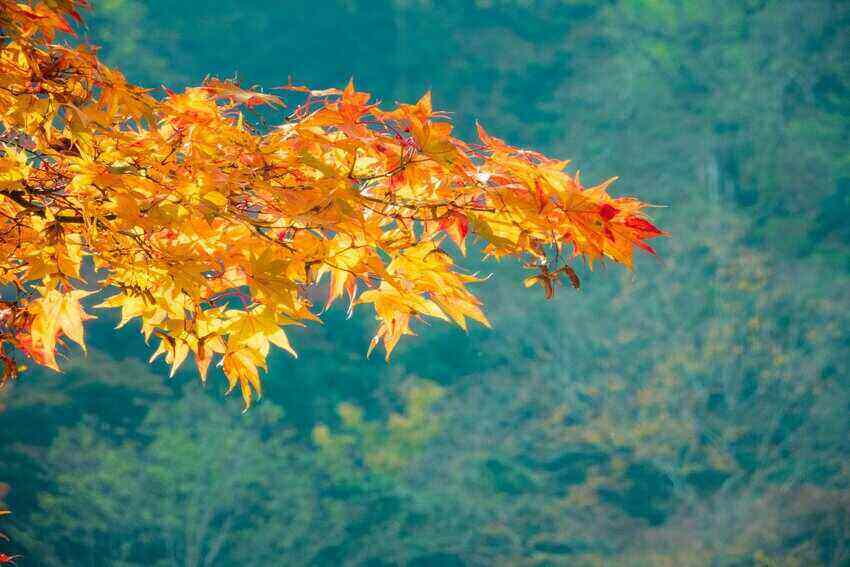You’ll be hooked after looking at the gorgeousness and aesthetics of the Japanese maple trees (like Sango Kaku). This kind of maple is more diminutive than others and has lacy, multicolored leaves. Now the fact is that most people often get confused about what type of maple tree they should get.
The most common names are Viridis and Waterfall maple tree. Now you may think what is the difference between Viridis vs waterfall Japanese maple. The basic difference is in the temperature tolerance and in the leaf’s color and form.
So, if you’re one of those who wants to know the difference in details then you have come to the right place. In this article, we’ll talk about the differences between these maple trees and will know more about the different varieties of Japanese maple trees that are available on the market.
Complete Guide on Japanese Maple Tree with Discussion on Viridis Vs Waterfall Japanese Maple

What Is Japanese Maple?
Japanese maple or Acer palmatum is a small and unique tree that can be grown both in the ground or in pots. Actually, it is one of the most typical trees for Bonsai. Japanese maple trees are basically famous for their exquisite and vibrant fall leaves.
These trees’ height ranges from 4 to 30 feet as they’re slow-growing, tiny species. In spite of the tree’s springtime blossoms, the five, seven, or nine lobed palmate leaves are what really catch the eye.
The majority of Japanese maples are hardy in USDA zones 5 to 8, although a few if planted in sheltered areas, may survive in USDA zone 4. Planting Japanese maples requires well-drained soil and full to partial light.
Because of the heat of summer in zones 7 to 8, the leaves of these plants might benefit from partial shade or dappled sunshine.
Types of Japanese Maple Trees
At present, Japanese maple trees have more than 2000 variations. Some of the prominent types of Japanese Maple Trees are-
- Coonara Pygmy maple tree
- Butterfly variegated maple
- Viridis maple
- Red dragon maple
- Crimson Queen maple
- Waterfall maple tree
- Emperor one maple
- Bloodgood maple
- Suminagashi maple
- Coral bark maple
- Autumn moon maple
- Golden full moon maple
- Green cascade maple
After knowing the names of different Japanese maple, let’s discuss some of their prominent types.
Crimson Queen Dwarf Japanese Maple
‘Crimson Queen’ The burgundy-red lacy leaves of the Japanese maple, a small ornamental tree, retain their color from spring through summer and become a brilliant scarlet in the autumn. As long as the laceleaf maple gets enough sunshine, it retains its brilliant foliage hues.
This maple tree forms a stunning bushy maple plant with its reddish-orange foliage. The width of the ‘Crimson Queen’ Japanese dwarf tree may reach up to 12 feet (3.6 meters) at its maximum height of 8 to 10 feet (2.4 to 3 m). It may be grown in USDA zones ranging from 5 to 9, even in full sun.
Coral Bark Japanese Maple
Coral gnarled ‘Sango-Kaku’ is a Japanese maple with ferny, 2-inch (5 cm) long leaves. From a yellow-green start to a light-green finish, their autumn coloration is a golden yellow.
This is what Coral Bark looks like. In addition to its gorgeous coral-red bark, Japanese maples have yellow, five-lobed leaves and a vase-shaped growth habit. Yellow palmate leaves against reddish-pink bark make the coral bark maple stand out among other trees of its species.
Viridis Maple
Dwarf, multi-stemmed ‘Viridis’ Japanese maples with lace-like leaves composed of thin, spiky blades. Leaf color changes from green to yellow or orange in the autumn on the lace leaf or cut-leaf Japanese maple tree.
Visual appeal is provided by the crookedness of the maple tree trunk and branches throughout the winter months in a Japanese maple. The USDA hardiness plant zone is 5 to 9 for Viridis maple.
It’s preferable to plant the Japanese maple ‘Viridis’ in partial shade. It’s a slow-growing maple that grows to a height of 8 to 10 feet (2.4 to 3 meters) and a width of 8 feet (2.4 meters).
Waterfall Maple Tree
The most spectacular example of cascading appearance is the waterfall Japanese maple. One of a kind in its habit of literally pouring down any bank or wall in its path, this tree is a veritable torrent of greenery. The waterfall maple plants USDA hardiness plant zone is 5-9.
During the summer, the leaves are a soothing shade of green but come autumn, they burst into a riot of yellow, gold, orange, and red. A wall or bank is the ideal location since it allows the liquid to run freely.
The foliage of laceleaf Japanese maples, which are green in the summer, transforms into a stunning array of colors in the autumn. This weeping maple, known as the “Waterfall,” has a large, wide-spread canopy. The dwarf maple grows to a height of 6 to 10 feet, with a crown up to 12 feet broad.
Butterfly Maple Tree
When the Acer palmatum Butterfly’s leaves are in bloom, they become a lovely shade of cream and pink. This majestic tree is perfect for balconies and patios with limited space. Divergent and delicate leaves make this plant one of a kind.
The Butterfly is unique in that it provides both tranquility and exhilaration at the same time. Small pots for patios and decks, and urban balconies, would benefit from this plant’s compact stature and narrow trunk. Perfect for a garden’s main entrance or as an eye-catching patio centerpiece.
Things to Consider While Choosing The Japanese Maple Tree
Whenever you want to get a Japanese maple tree you should consider some major factors. So, let’s check them out.
Zone
Most of the Japanese maple trees do well in the warmer zone basically in the 5 to 8 zone. However, in the severe winter, they won’t survive but if you put them in a container and maintain the temperature zone they may survive.
Size
After the zone, the next thing that has to be on your priority list is the size. Japanese maple tree ranges from 2 to 30 feet. So, you have to decide how tall you want for the garden. For example, if you want a maple tree of 2 to 5 feet then the dwarf maple trees are the right option.
Leaves
The two main categories of Japanese maple leaves are palm-shaped and lacy. However, it’s common for one’s decision to be influenced by the aesthetics of the garden or the buildings in the immediate vicinity.
Difference Between Viridis and Waterfall Japanese Maple
Viridis (Laceleaf) and Waterfall (weeping) Japanese maple trees have lots of similarities but they have some differences too. The similarities of these deciduous trees include their green shed, height, USDA hardiness plant zone, etc.
Both of them are also derived from the same species like Acer palmatum, Acer sieboldiaum, Acer shirawanum, Acer japonicum, Acer buergerianum, and many more where the majority of them have come from the Acer palmatum group.
After knowing the likenesses, let’s know the difference between Viridis vs Waterfall Japanese maple trees.
Leaves Color in Sunburn
‘Viridis’ competes with ‘Waterfall’ in terms of temperature tolerance. As far as mentioned before, Viridis is the first green-leafed laceleaf maple.
The green leaves of the Viridis maple tree become orange or brown in the heat of the day. But waterfall maple has better sunburn resistance and maintains the green color well.
Leaves Color in Seasonal Change
In autumn, both Waterfall and Viridis Japanese maple change their leaves’ color but in different hues. This is another distinctive feature between them.
Seasonal changes transform the Viridis tree leaves into a stunning display of gold and yellow. Whereas autumn turns the Waterfall foliage into gold, red, and orange hues.
Tree Shape
Viridis and Waterfall maple trees look almost similar. But the waterfall maple plants’ branches are quite rounded. On the other hand, Viridis maple plants are more scriptural than the waterfall Japanese maple.
Growth Rate
Some gardeners claim that the Viridis maple tree is a little slow-growing plant than the Waterfall maple tree. But this is not universal truth actually.
Conclusion
Japanese maple is a widely used bonsai tree that can be planted both in soil and containers. They are available in different varieties and all of them have a unique appeal. Viridis and Waterfall maple are two special cultivars of the Japanese maple tree.
When discussing Viridis vs Waterfall Japanese maple, Viridis maple will change the leaves shed due to temperature change while waterfall maple will hold the actual color. During fall when leaves fall down naturally Viridis foliage turns into gold and yellow color (like Asiatic lily leaves) but the waterfall foliage turns into red, gold, and orange shed.
Hopefully, now you get a clear idea of Japanese maple and its prominent cultivars. So, it’s your turn to decide now, which one will you choose!
Video on some Japanese maple tree variations:

I’m Shofi, a passionate gardener and blogger. I have 10+ years of experience in gardening and hold certifications in horticulture and garden design. I share my knowledge and skills through my garden blog to inspire and educate others on the joys of gardening. I try to provide valuable information and create a community for gardeners of all levels to connect and learn. My ultimate goal is to inspire others to start their own gardens and connect with nature.
